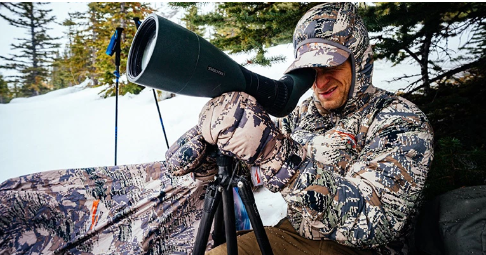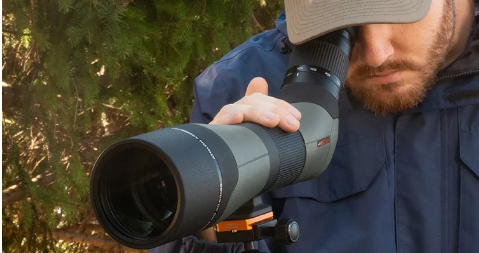Spotting Scope vs. Binoculars

Before deciding on a spotting scope, it's important to consider if a spotting scope or binoculars are better for your needs. Each is better suited to certain circumstances. Many outdoor enthusiasts will use a combination of both spotting scopes and binoculars-spotting scopes to scout distant areas and binoculars for quick scans while moving through an area.
Spotting scopes have higher magnification power, allowing you to zoom in and out. This makes them great for those observing at longer distances since you have a greater range of magnification and have the power needed to see far-away objects. They are larger than binoculars and are best used with a tripod, so while they offer a great view they are less portable than binoculars. Spotting scopes are best when you're getting the lay of the land or scanning for potential targets at greater distances.
While binoculars don't have the magnification power of spotting scopes, they are extremely portable. You can easily carry them through the field with a harness, keeping them accessible so you can use them whenever needed. If you don't need to scout far away or want portability over zoom, binoculars are the best option for you.
Spotting Scope Parts

Spotting scopes have four main components: the tube, the eyepiece, the objective lens, and the focusing wheel.
The tube is the main body of the spotting scope, running from the eyepiece to the objective lens.
The eyepiece is the lens you'll look through when using the spotting scope.
The objective lens is the large lens at the end opposite the eyepiece. The objective lens gathers light and sends it through the internal prism system, creating the image you see in the eyepiece.
The focus adjustment is a knob or dial that allows you to adjust the focus of the spotting scope. These are most often a knob that extends out of the scope or a ring around the body of the spotting scope.
Types of Spotting Scopes
There are two common types of spotting scopes: angled and straight tubed. While both provide a detailed image of far-away targets, each has its own advantages in certain situations.

Angled spotting scopes have an eyepiece that angles upwards. These are often easier to use by hand, since the length of the body is shorter and the weight is centered. Most angled scopes also have a rotatable eyepiece, allowing you to adjust it and find a comfortable viewing position. Because the eyepiece is higher up, you won't need to have as tall of a tripod either, making for more comfortable viewing sessions. The angled design also makes it easier to look from lower positions.
Straight spotting scopes are longer and look similar to a telescope. The long, straight profile makes it easier to fit this type of spotting scope in a pack. If you're glassing with binoculars on the same hunt, a straight spotting scope will also make it easier to reacquire your target when switching optics. Since binoculars and a straight scope have the same general position, you can see the same target without the need to adjust your tripod. However, they can cause neck discomfort since you'll need to crouch slightly to see through the scope when mounted on a tripod. Straight spotting scopes are easier to use from elevated positions, since the straight tube allows for comfortable viewing when looking down to lower elevation.
If you'll use the spotting scope most often while sitting or standing, it's best to choose an angled spotting scope. This will give you the most comfortable viewing position. If you plan to glass from a prone position or plan to use both binoculars and a spotting scope on the same hunt, choose a straight spotting scope.
Features to Consider
Once you know which type of spotting scope you want, you can start narrowing down your choices with other important features like magnification power and the size of the lenses. We've broken down a few of the most important features to look for when choosing a spotting scope.

Magnification
Magnification indicates how zoomed in the image you see through the scope will appear relative to your naked eye. For example, a 20x spotting scope will make something appear 20 times larger than it does when viewed without the scope.
Fixed power scopes have a single magnification power and cannot be adjusted.
Variable power scopes have an internal mechanism to adjust the magnification. The magnification power of a variable power scope is expressed as a range. For example, a 20–60x80 scope can be adjusted for a magnification anywhere between 20x and 60x. Most people should choose a variable power spotting scope, since this allows you to zoom in and out as needed.
Objective Lens Diameter
The objective lens diameter represents the size of the objective lens in millimeters. This is the number after the x in a spotting scopes number: for example, a 20–60x80 spotting scope has an objective lens diameter of 80mm. The larger the objective lens diameter, the more light will enter the optics system and the brighter the image. Larger objective lenses also tend to have a higher maximum magnification since the added light-gathering power allows more detail when zoomed in.
Eye Relief & Exit Pupil

Eye relief indicates how far away the spotting scope should be from your eye for optimal viewing. For example, if a spotting scope has an eye relief of 3-inch, the eyepiece lens should be three inches from your eye to get the best image possible.
The exit pupil is the aperture in the objective lens that allows light to enter the optics system. The larger the exit pupil, the more light will enter the scope and the brighter the image will be. The exit pupil is calculated by dividing the objective lens diameter by the magnification power. For example, a 20-60x85 spotting scope has a maximum exit pupil of 4.25mm (85/20). Use our chart below to find the recommended exit pupil based on the time of day you'll most often use the scope. Keep in mind that the exit pupil is based on the magnification and will get smaller as you zoom in with a variable power spotting scope.
| Viewing Time of Day | Exit Pupil |
|---|---|
| Bright Light | 1.5mm and lower |
| Daylight | 2mm to 4mm |
| Dawn/Dusk | 4mm to 6mm |
| Nighttime | 6mm to 7mm |
Field of View

The field of view indicates the amount of the horizon you'll see at the noted distance. For example, a spotting scope with a field of view of 122 meters at 1,000 meters will allow you to see 122 meters across the horizon if you're looking 1,000 meters away. The field of view is often expressed as a range, for example 108–60 feet @1000 yards. This indicates the field of view at the lowest magnification setting (108 feet) and the highest magnification setting (60 feet).
Focus Adjustment
You'll also want to consider the style of focus knob on your spotting scope. All focus knobs will allow you to adjust the image for optimal clarity, but each works a little differently.
Single focus knobs have one dial to adjust the focus. These are the most common type of focus knob and offer precise focus. However, they take a little longer to dial-in than other focus knob styles.
Double focus knobs have two knobs: one for coarse focus and on for fine focus. This style makes it easy to make both large adjustments and more precise focus adjustments.
Helical focusers have a ring around the scope's body. To adjust the focus, you rotate the ring clockwise or counterclockwise. They are great for making adjustments quickly and are especially helpful when observing objects that change distances.

With the right spotting scope, you'll be ready to scan the horizon and enjoy your time outdoors. Whether you're scouting in the backcountry or observing nature, having a spotting scope suited to your needs will make your experience much more enjoyable. If you have any questions about choosing the best spotting scope for you, stop by your local SCHEELS and see one of our Optics Experts.




